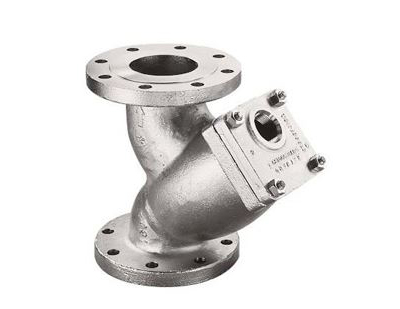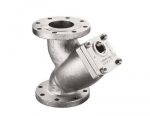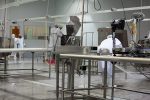Using electrostatic technology in food processing isn’t a new idea. It has been around for years, but no one has been able to effectively harness the possibilities of this method for pathogen reduction. That’s all changing thanks to the research and dedication of a food safety group made up of experts and leading protein processors.
Now, food companies of all types stand to benefit from an innovation with the potential to revolutionize the industry. For the first time, there is a way to use electrostatics to deliver antimicrobial intervention with a high level of efficacy and minimal resources.
Less water, less chemical and better coverage—it almost sounds too good to be true. But it’s a reality, and it came from a focus on providing better protection with precision application.
The Basics of Electrostatics in Food Safety
The ultimate goal of using electrostatic technology in food processing is to achieve a high level of transfer efficiency. In terms of antimicrobial use on food products, that concerns how well a processor is able to cover products with a solution over a 360-degree surface.
There’s a large amount of waste, or very low transfer efficiency, that comes with current antimicrobial intervention methodologies. Most food processing operations either use a lot of water and chemical solution to cover a less-than-ideal surface area, or they use an enormous amount in an attempt to get better coverage.
The hope for electrostatics has been that it could improve transfer efficiency by applying opposite charges to food products and antimicrobial solutions. Opposites attract. Positively charged particles are drawn to negatively charged particles, and so, an antimicrobial intervention, such as peracetic acid (PAA), should better adhere to protein products if the two have opposite charges.
In theory, the science seems very simple. But in practice, finding ways to use electrostatics effectively was an extensive, eye-opening journey. It took a team of scientists, food safety thought leaders, and participation as well as funding from three top beef processors to find the answer.
Research and Development
The food safety group, which included Keith Belk, Ph.D. of the Colorado State University Center for Meat Quality & Safety, spent years experimenting, testing and fine tuning electrostatic application technology to make it as precise as possible.
In the beginning, there was no clear indication whether the efforts would produce results. The group didn’t know which type of electrostatic technology would work, what parameters should be used or if any of it would be effective. Just as Thomas Edison experienced many failed attempts while inventing the electric lightbulb, our group went through a series of exercises that eventually led to the right type of electrostatic application. Yet just as importantly, we discovered many methods that did not work.
For example, testing showed that applying a charge at the spray nozzles was not a good way to harness the potential of electrostatics. The charge was too difficult to control using this approach. Eventually, researchers found the best way to achieve transfer efficiency was to apply a negative charge directly to the source of the antimicrobial intervention. This allowed the negatively charged solution to effectively adhere to the positively-charged meat product with maximum control of the operating parameters.
Interestingly, while the group explored a variety of ways to apply antimicrobial intervention using electrostatics, applying a charge to the source proved to be the only technique that worked. The rest had virtually no impact.
After identifying the right approach, there were still big questions researchers wanted to answer. One such question was what happens when a vacuum is applied to the process? Would it work better, worse or have no bearing on the results?
Theoretically, the group thought a vacuum might aid in the process by opening up the surface of the meat, allowing for deeper penetration and further reduction of pathogens. However, tests revealed that applying the antimicrobial solution with electrostatics in a vacuum provided no additional benefits.
The next step was developing a prototype system to support both beef and poultry processing. Finding ways to control electrostatics and achieving transfer efficiency in a pass-through system proved to be challenging. Food production lines don’t stop, which means antimicrobial intervention can’t be done in batch mode.
The final equipment design included a conveyor system that slowly rotates to expose all surfaces of the product as it moves through the line while maintaining constant line speeds.
The Results
In-plant testing at beef processing facilities proved just how much of a difference electrostatic technology will make for food companies looking to improve efficiencies and strengthen food safety efforts.
During recent tests, researchers ran the system at a high volume between 265 and 700 pounds per minute using peracetic acid at approved levels between 1600 and 1800 parts per million (ppm). The results showed a log reduction in the range of 2.1 to 2.6 with an average of 2.4 on a series of tests. That is outstanding, especially considering many facilities typically achieve a log reduction of around 1.0 to 1.5. Plus, most food manufacturers are using substantially more antimicrobial solution to achieve that sort of pathogen reduction.
Results from laboratory studies show the technology provided equal coverage to a dip tank, but it used 95% less solution. Dip tanks are common in poultry processing, but they are very inefficient and waste a tremendous amount of water and chemical. Poultry facilities switching to electrostatic intervention technology would use a fraction of the water and chemistry, greatly improving efficiency.
Beef and pork processing facilities use sprayers for antimicrobial solutions and are much less likely to use dip tanks, as they’re not a viable intervention method for an operation of that scale. However, sprayers alone may not provide adequate coverage, creating the possibility for food safety risks.
Beef and pork plants could achieve better coverage with electrostatics while using the same or even less solution. That’s because the preciseness of this innovative approach also eliminates waste that comes from over spraying.
The Potential Benefits of Adopting Electrostatic Technology
How much of an advantage a food processing facility gets from implementing electrostatics into its antimicrobial intervention process is very dependent on the type and size of the operation as well as its current approach to food safety. There are, however, several major benefits that any food company will realize after adopting the technology.
- Improved food safety. Processors can be confident they are achieving 360-degree coverage while bolstering efforts to eliminate pathogens on food products.
- Efficient use of water and chemical. The precision achieved from utilizing electrostatics has the potential to dramatically reduce waste without compromising food safety. High transfer efficiency means processors save money and resources.
- Reduced water treatment costs. Protein processing facilities have large amounts of waste water that need to be treated in-house. More efficient use of antimicrobial solution significantly reduces money and resources needed for water treatment.
- Reduced repair and maintenance costs. Because of the acidic nature of food safety chemicals such as PAA, overspray of antimicrobial solution can unintentionally land on other surfaces and equipment. The low pH levels can lead to corrosion and damage, requiring repairs or additional maintenance. But, precise application with an electrostatic method within an enclosed space reduces the overspray problem.
- Better indoor air quality (IAQ). Another side effect from over spraying is chemical odors in the plant. Here again, protection with precision offers a unique benefit. Minimization of overspray improves IAQ, producing a safer and healthier environment for workers.
An additional benefit of electrostatic intervention technology is that it allows for precise measurement of the degree of the charge applied at the source, the concentration of the chemical in the solution and the overall transfer efficiency. While the original food consortium involved members of the protein industry and was optimized for use by meat processors, produce and fresh-cut facilities also stand to benefit from implementing electrostatic technology.
Changing the way your plant operates may feel risky, and being among the first to adopt an innovation can come with some uncertainty. However, in this case, avoiding early adoption could put you at a disadvantage, and the food safety risks are greater than those associated with pursuing this opportunity.
Electrostatic technology for antimicrobial interventions provides impressive advances in efficiency while offering protection–for both the public’s health and safety as well as brand reputation. The future of food safety looks precise.



















